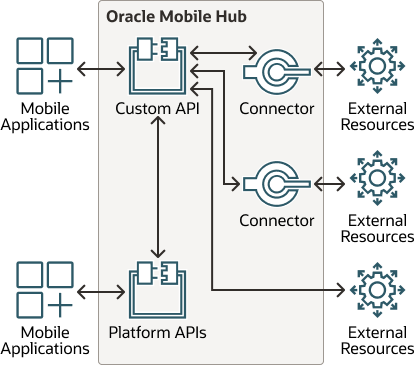Learn About APIs for Your Mobile Apps
Oracle Mobile Hub handles authentication and authorization, and also provides services such as storage and offline sync. You can use Mobile Hub to manage access to public APIs such as Google Maps and the like, and you can create custom APIs that connect to your enterprise systems, whether they're on-premises or in the cloud.
Oracle provides client SDKs for Android, iOS, Cordova, React Native, and browser-based JavaScript apps. The SDKs help you use Oracle Mobile Hub features and APIs in your apps. Oracle also provides sample apps for Android and iOS that you can learn from and use as models for your own apps. Custom code test tools are also available for offline development and testing.
You can use Oracle Live Experience Cloud Service to add video, audio, and screen sharing to your mobile apps. Before you configure Live Experience, ask your Live Experience system administrator for the endpoint, client ID, and client secret. The system administrator obtained those values when the account was configured. You'll need to configure both your Oracle Mobile Hub environment and your backend to use Live Experience.
Architecture
This architecture diagram shows some of the ways that your mobile apps can use Oracle Mobile Hub and its back end services.

Description of the illustration architecture-mobile-apps-omh.png
The diagram shows the following possible scenarios:
-
Your mobile app calls a custom API that you write. The custom API can then communicate with one or more platform APIs before sending a response. It can also communicate with external resources such as your on-premises enterprise systems or public resources such as Google Maps. The custom API can either communicate directly with the external system, or it can communicate with the help of a connector that you create and configure.
-
Your mobile app calls one or more platform APIs directly. Platform APIs are built into Oracle Mobile Hub and provide services such as location, notifications, storage, user profile information, and more.
Custom APIs
You create a custom API by defining the endpoints in Oracle Mobile Hub first, and then writing their implementation.
After you create the endpoints for a custom API, a mock implementation is created automatically based on the endpoints that you defined. You can use the mock implementation for preliminary testing and validating before starting on code development. You then write the API's implementation in JavaScript for a Node.js Express environment.
You can also use the custom code test tools that Oracle provides to automate testing and uploading your implementation to Oracle Mobile Hub.
Platform APIs
Oracle Mobile Hub provides several platform APIs that you can use in your mobile apps.
The platform APIs include the following features:
-
Notifications: Send notifications to your mobile apps.
-
My Profile: Retrieve the current app user’s profile.
-
Storage: Work with collections and objects such as images and documents that you associate with your backend.
-
Data Offline and Sync: Build applications that cache REST resources for offline use and then synchronize all offline changes with the server when the device goes online again.
-
Location: Define location devices and places and query for them from your mobile apps.
-
Database Access and Database Management: Access the database that's associated with your Oracle Mobile Hub instance.
-
App Policies: Retrieve application configuration properties that you have set in the backend.
Connectors
When you funnel calls from a custom API through a connector, you can filter and shape the data that goes to and from the external resource. The connector generates logs for tracking, debugging, and analytics.
Connectors are declarative. You use the Connector UI to configure the target URLs, security properties, and other rules. You don't need to write any code to create a connector. And although Connectors can be accessed only from custom APIs, you don't always need to write the custom API yourself. You can automatically generate a custom API for REST connectors and for Oracle Fusion Cloud Applications connectors.
If you have a Swagger descriptor for the external resource you can use it to generate appropriate endpoints and modify them as needed for your application. If the third-party interface changes, you can modify your connector to adapt to those changes and leave your mobile app code as-is.